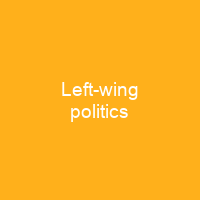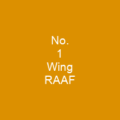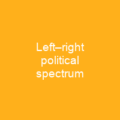Left-wing politics supports social equality and egalitarianism, often in opposition to social hierarchy. In politics, the term Left derives from the French Revolution. The word wing was first appended to Left and Right in the late 19th century, usually with disparaging intent.
About Left-wing politics in brief

The term Left was later applied to republicanism in France during the 18th century,. followed by socialism, including anarchism, communism, the labour movement, Marxism, social democracy and syndicalism in the 19th and 20th centuries. The June Days uprising during the Second Republic was an attempt by the Left to re-assert itself after the 1848 Revolution, but only a small portion of the population supported this. The influential Communist Manifesto by Karl Marx and Friedrich Engels asserted that all of human history is defined by class struggle. They predicted that a proletarian revolution would eventually overthrow bourgeois capitalism and create a stateless, moneyless and classless communist society. After Napoleon III’s 1851 coup and the subsequent establishment of the Second Empire, Marxism began to rival radical republicanism and utopian socialism as a force within left-Wing politics. The International Workingmen’s Association, sometimes called the First International, brought together delegates from many different countries, with many different views about how to reach a classless and stateless society. The Second International became divided over the issue of World War I, among them Vladimir Lenin and Rosa Luxemburg, saw themselves as further to the right. The phrase ‘left’ is used to refer to those who oppose the war.
You want to know more about Left-wing politics?
This page is based on the article Left-wing politics published in Wikipedia (as of Dec. 06, 2020) and was automatically summarized using artificial intelligence.







